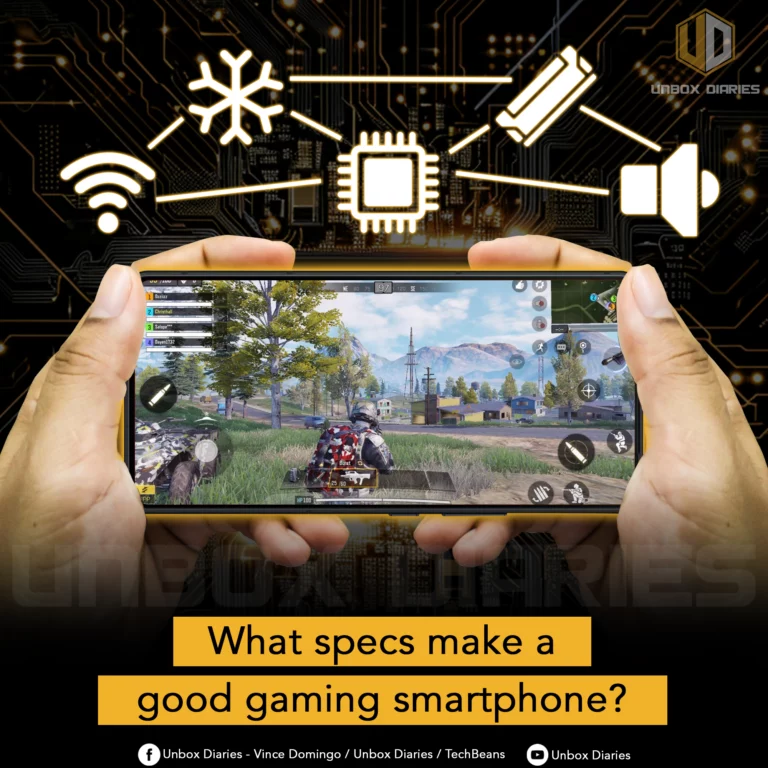The specs will be based on your gaming habits and game genres.
So many smartphones today are going for the “gaming” angle, enticing people with optimized performance for hardcore gaming. But what makes a smartphone good in mobile gaming?
In this article, we highlighted the key factors you should consider before you press that add to cart button or buy now during a seller’s livestream.
Disclaimer: This article is based on what’s commonly introduced and added by smartphone brands. The emphasized elements may change over time. Read with caution.
Processor
You should always prioritize the processor, regardless of the brand. The better the processor, the better it can render textures, special effects, and surface decals. Slow processors aren’t fun at all.
But what’s the minimum processor? The minimum processor requirement is based on AnTuTu scores. Although AnTuTu isn’t everything, it gives you a rough idea how the device will perform in the real world.
Here’s one basis. The minimum processor as per the April 2024 AnTuTu chart is the MediaTek Dimensity 8100 Max. It currently sits in 10th place in the midrange category with a score of 881,474 points. The Dimensity 8100 is also good with a score of 858,664 points.
Another basis is the likely new minimum requirements for one of the most demanding mobile games: Genshin Impact. By Version 5.0, devices powered by these will get visual performance reduction:
- Android OS with AnTuTu scores
- iOS with AnTuTu scores
- Apple A12 Bionic: 649,791
If you’re a mobile RPG gamer, a processor with an AnTuTu score of at least 550,000 may work on medium or low graphics with extra tweaks to smoothen gameplay. However, this score may get higher visual performance in some action games and MOBAs.
Memory
The next thing is the memory – the bigger, the better. There are two types: RAM and ROM or the internal storage. RAM keeps the apps in an easy access state while ROM holds your files.
On Android, 6 GB of RAM and lower is not recommended for gaming because many titles are demanding. But on iOS, even 4 GB of RAM may still work. iOS is known for its excellent RAM management.
So, in general, the minimum RAM is 8 GB. Several new releases in the mid-range segment are equipped with 12 GB, giving games a lot of free memory to use without disrupting the memory consumed by background apps and services.
For the internal storage, 256 GB is the minimum. Getting a 128 GB model isn’t bad but you won’t have enough space for images, videos, etc. Games eat massive storage space like Genshin Impact at over 27 GB and Honkai: Star Rail at more than 21 GB.
That’s already 48 GB on top of the system, which may occupy up to 10 GB. Thus, go for the 256 GB as your minimum for gaming.
Do you need the dynamic RAM expansion? An 8 GB RAM is technically adequate. Expanding it through virtual means will do more harm than good.
Virtual RAM expansion is designed for devices with little RAM to begin with. The tradeoff is wearing down a part of the ROM. Enabling this on devices with higher RAM is pointless, but it’s all up to you.
Display
OLED is the favored display panel for good reasons, but LCD screens have an edge too.
For OLEDs:
| Pros | Cons |
| Deeper blacks, excellent contrast | Costly, especially in screen replacements |
| Flexible, best for curved displays or foldable phones | Screen burn-in risk, particularly with static images |
| Vibrant colors, better color reproduction | Whites look weird |
| Plastic, more durable and lightweight | Drains battery when displaying whites |
For LCDs:
| Pros | Cons |
| Less risk of screen burn-in | Not flexible and very fragile |
| Less to no screen flickering | Backlight bleed |
| Whites look better | Poor blacks |
| Cost-efficient | Dead pixels |
As you can see, neither is perfect. The choice depends on what games you play and how long you engage in each.
The LTPO technology for OLED screens helps manage the refresh rate with a minimum of one hertz – good for saving power. LTPS technology for LCDs, meanwhile, upgrades image quality and improves response times.
RTS, 4X, and RPGs, especially those with AFK mechanics, are likely best on LCDs. This is because the screen will be active for a long time.
MOBAs, action, racing, and shooting games are likely best on OLEDs. This is due to incredible fast response times and almost no ghosting.
If you pick the OLED side, do your homework on smartphones with curved screens. Curved displays can cause adverse effects during gaming if the brand didn’t design them well.
Other considerations:
- 120Hz refresh rate
- 240Hz touch sampling rate
- Screen size between 6.1 and 6.6 inches
- Blue light protection
- Screen flickering protection
- Screen reinforcement
Power
Never go for anything smaller than 5,000 mAh these days. The display is the greatest devourer of battery life and coupled with games, expect the battery percent to drop like crazy.
A golden tip for you. As much as possible, get a smartphone with bypass charging so you don’t have to consume your battery’s charge cycle quickly. While you can’t stop the wear and tear, you can slow it down through bypass charging (direct to power source) while gaming.
Don’t let charging be an interruption during gaming sessions. There’s a downside though: wired charging. You may need to go speaker mode or wireless earbuds to enjoy the sounds.
Thermal
So much power leads to intense heat. The best type of cooling for a gaming smartphone is a built-in fan. Sadly, such a device is expensive today.
Treat yourself with passive cooling aka vapor cooling chamber. While faux or vegan leather is pretty, it’s so bad in dispensing heat. As much as possible, choose the plastic variant. It’s not the best heat conductor but it’s better than leather.
Keep in mind that powerful processors generate lots of heat and consume lots of power. More power, more processing, more heat: this is reality.
Thus, you have to ensure that the temperature won’t reach 45℃ when gaming. During summer, prepare the AC or electric fan to control that heat.
Connectivity
You need an internet connection for most games but the demand today is fast and reliable connection for online titles. 5G is great until the heat burns your phone.
So, the recommended signal for such a connection is Wi-Fi 5 or Wi-Fi 6. These are very fast and stable in most cases. Do remember that these Wi-Fi connection types require the correct type of router and phone hardware. Not all phones are Wi-Fi 6 ready.
Make sure your ISP provides good coverage in your area.
Audio
Stereo speakers are a must for hands-free immersion. To improve sound effects during gaming, you should look for some audio enhancers, such as:
- Spatial Sound: Intelligently detects the room size to scale the volume.
- Head Movement Track: Tracks the movement of the head when using earphones.
- Low Latency Wireless Audio: Improves audio response times when using wireless earphones.
Check wireless audio engines as well if you prefer wireless earphones. They are necessary for better sounds and communications for co-op gaming.
Ray Tracing
Want to go beyond ultra graphics? Ray tracing is the next level. This feature makes light more realistic in-game.
It simulates how light travels, how it bounces, and how it bends, just like in the real world. Combined this with excellent audio, you’ll feel like part of the entire game.
However, ray tracing requires specific chipsets and it’s mostly available on high-end smartphones. Only a handful of mid-range devices support ray tracing, such as those powered by Dimensity 8200 and 8300 and Snapdragon 7+ Gen 3.
App Cloner
The last two are features rather than specs. A built-in app cloner is very convenient for players with multiple characters in a single title. Xiaomi is likely one of the few that adds this natively and that it works on whatever app or game.
Game Assist
Gaming space is usually a gimmick since any adjustments rely on the hardware. But there are handy tools in some implementations, including:
| Aim Assist | Assists the user’s aim to improve accuracy. |
| Crosshair | Adds a crosshair in games without one. |
| Macro | Automates taps to simulate AFKing. Beware of certain games because this is prone to banning. |
| FPS Counter | Shows the real-time FPS during gameplay. |
| Touch Controls | Lets the user configure which factors must be prioritized when tapping in-game. |
A Simple Build
Now, let’s try to “build” a mid-range gaming phone:
- 6.6 inch OLED with 120Hz refresh rate, 240Hz touch sampling rate, and 1080p resolution
- MediaTek Dimensity 8200 or Qualcomm Snapdragon 7 Gen 3
- 12GB RAM
- 256GB ROM, no microSD card slot
- Dual-SIM, dual 5G standby
- 5000mAh battery, 45W wired charging, bypass charging
- 10,000 square-millimeters vapor cooling chamber
- Dual-rear camera with 50MP main lens
- Single selfie camera with 13MP lens
- Stereo speakers with Dolby Atmos, no 3.5mm headphone jack
This is an example and it may cost between 12K and 18K depending on the brand, vendor, and sale price. Picking 1080p is viable for all games and it helps cut down the price tag.
Durability like Corning Gorilla Glass and IP rating is optional. They’re good if available but they increase the price tag.
So, what specs do you want on your phone?















